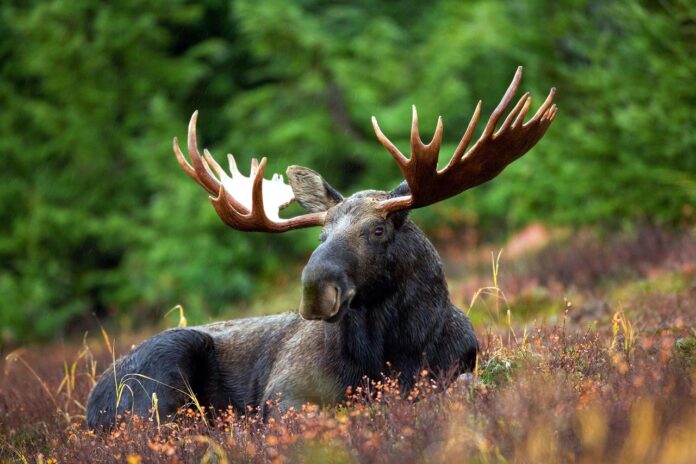The moose is a large, strong animal with a sturdy build. It has long, powerful legs, massive shoulders, an expanded chest, and a large head on a relatively short neck, giving it a distinctive shape. Its withers, along with the hair covering them, form a pronounced hump. The head is large, elongated, and narrow. The nostrils are slanted, with large, downward-facing openings.
Moose legs end in four “toes,” with the last segments protected by thick skin. Moose have glands that secrete aromatic substances (pheromones), giving them a scent highly specific to humans. This scent helps moose find lost kin, while males use it to locate nearby females.
Habitat Location
In North America, moose can be found across the northern tier of the continent, including Alaska and large parts of Canada. Their range extends southward into the continental United States, where they inhabit parts of New England in the east.
The Eurasian moose has a continuous range covering all of Scandinavia and stretching eastward to Siberia, southward to certain countries in continental Europe and Asia, including Poland, Germany, Estonia, Latvia, Lithuania, China, Kazakhstan, and Mongolia. A small moose population once lived in Austria but is now considered extinct.
Distribution
Moose are typically forest-dwelling animals. They are commonly found in vast, swampy or wet forests, bog pine forests, and willow thickets, often near swamps, especially if there are higher, forested areas nearby. Moose are highly adaptable to their surroundings, and although they prefer natural forests, they are increasingly found in managed forests, even near heavily populated areas.
Diet
Due to its body size and the proportions of its legs and neck, the moose is adapted to feed on plants 50-200 cm in height. Its long, prehensile upper lip and mobile tongue help efficiently browse woody plants, sipping sap from leaves and buds.
Moose particularly enjoy pine, juniper, fir, larch, and spruce, which provide high-calorie food in the form of needles, buds, shoots, and seeds. In the summer, a moose requires about 30-50 kg of food per day, 12 kg in the winter, and 10 kg in the spring.
Dangers and Defense
The moose’s most dangerous natural predator is the gray wolf, which controls population numbers by preying on the weakest and oldest moose. Wolves may even hunt large male moose. Bears also occasionally attack young or sick moose. Smaller predators do not risk confronting adult moose.
Moose populations have significantly declined in the past due to overhunting, deforestation, drainage, and reforestation of moorlands. In the Caucasus and Western Europe (outside of Scandinavia), the moose became extinct, while populations in Central Europe and parts of North America nearly disappeared.
Abilities
Moose have excellent senses of smell and hearing, though their vision is somewhat poor. They locate submerged plants by touch. From birth, moose calves emit high-pitched cries to attract their mother’s care or attention. Later, they communicate with their mother through gestures rather than sounds.
Moose’s unusually long legs are well-suited for navigating through mud, water, or snow, as well as crossing off-road obstacles. They are also excellent swimmers. Moose are most active at dawn and dusk. On windy days, they are often inactive and stay in their dens. In their favorite refuges, with plenty of food and water, moose tend to be idle.
Moose and Humans
Moose have been admired by humans since the Paleolithic era, as evidenced by cave paintings (Scandinavia), petroglyphs (Central Asia, Siberia), and clay and bone figurines (Siberia). Ancient depictions of moose can also be found on Scythian ornaments. The oldest written description of the moose comes from Julius Caesar, who claimed that moose sleep while leaning against trees because they lack joints in their legs and cannot lie down.
In Sweden, Finland, Russia, and Siberia, people have attempted to domesticate moose. They were raised for meat, leather, and milk, the latter believed to have healing properties against tuberculosis. However, moose did not prove to be promising livestock, as they are difficult to breed in large herds, require vast space, have specific dietary needs, and reproduce slowly.
In the 18th century, there were attempts to use moose for riding in swampy areas of Sweden and Finland. According to the Finnish epic Kalevala, the witch-singer Väinämöinen rode a moose. Nevertheless, domesticating moose failed due to their temperamental nature and sensitive skin, which could not tolerate saddles or harnesses. Some monarchs, such as the Swedish king Charles XI or the Russian Empress Catherine the Great, banned the use of moose for riding.
Interesting Facts
- Moose are the largest members of the deer family in the world, standing up to 180 cm at the shoulder, with a body length of about 3 meters, and weighing up to 800 kg.
- Their antlers can weigh up to 20 kg!
- Unlike deer, moose are not easily spooked. They may not quickly flee from humans.
- A large moose population exists in Finland, where they are iconic animals. Road signs even warn drivers of moose crossing areas.
- In various mythologies, moose symbolize strength, steadfastness, and truth.
- Despite their size, moose are fast. They can reach speeds of up to 60 km/h over short distances and usually move at a trot.
- The largest recorded moose weighed 825 kg, stood 2.34 m tall, and had antlers nearly 2 m wide! This moose was found in 1897.
- Moose shed their antlers annually. After a male moose turns one year old, antlers grow and increase in size each year. By November-March, antlers fall off without harm to the moose.
- Moose calves grow rapidly, gaining 2-4 kg daily during their first year and 8 kg per day during peak growth.
- Moose only live in areas with snow cover in winter and cannot tolerate temperatures above 27°C.
